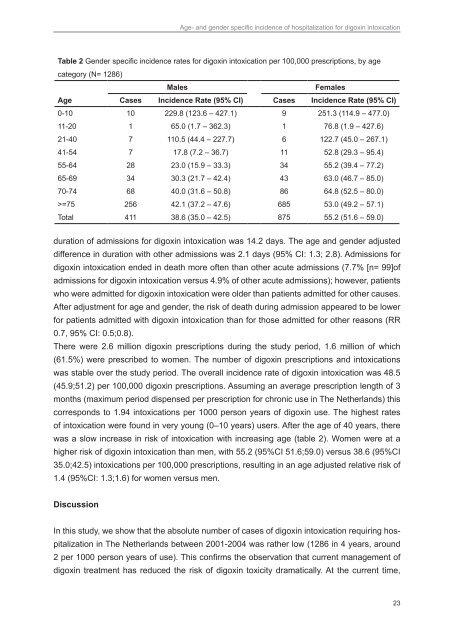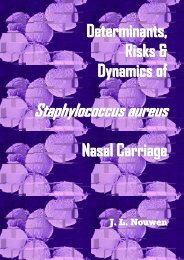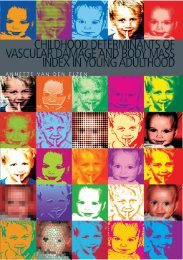Genetic susceptibility to adverse drug effects - Epidemiology ...
Genetic susceptibility to adverse drug effects - Epidemiology ...
Genetic susceptibility to adverse drug effects - Epidemiology ...
Create successful ePaper yourself
Turn your PDF publications into a flip-book with our unique Google optimized e-Paper software.
Age- and gender specific incidence of hospitalization for digoxin in<strong>to</strong>xication<br />
Table 2 Gender specific incidence rates for digoxin in<strong>to</strong>xication per 100,000 prescriptions, by age<br />
category (N= 1286)<br />
Males<br />
Females<br />
Age Cases Incidence Rate (95% CI) Cases Incidence Rate (95% CI)<br />
0-10 10 229.8 (123.6 – 427.1) 9 251.3 (114.9 – 477.0)<br />
11-20 1 65.0 (1.7 – 362.3) 1 76.8 (1.9 – 427.6)<br />
21-40 7 110.5 (44.4 – 227.7) 6 122.7 (45.0 – 267.1)<br />
41-54 7 17.8 (7.2 – 36.7) 11 52.8 (29.3 – 95.4)<br />
55-64 28 23.0 (15.9 – 33.3) 34 55.2 (39.4 – 77.2)<br />
65-69 34 30.3 (21.7 – 42.4) 43 63.0 (46.7 – 85.0)<br />
70-74 68 40.0 (31.6 – 50.8) 86 64.8 (52.5 – 80.0)<br />
>=75 256 42.1 (37.2 – 47.6) 685 53.0 (49.2 – 57.1)<br />
Total 411 38.6 (35.0 – 42.5) 875 55.2 (51.6 – 59.0)<br />
duration of admissions for digoxin in<strong>to</strong>xication was 14.2 days. The age and gender adjusted<br />
difference in duration with other admissions was 2.1 days (95% CI: 1.3; 2.8). Admissions for<br />
digoxin in<strong>to</strong>xication ended in death more often than other acute admissions (7.7% [n= 99]of<br />
admissions for digoxin in<strong>to</strong>xication versus 4.9% of other acute admissions); however, patients<br />
who were admitted for digoxin in<strong>to</strong>xication were older than patients admitted for other causes.<br />
After adjustment for age and gender, the risk of death during admission appeared <strong>to</strong> be lower<br />
for patients admitted with digoxin in<strong>to</strong>xication than for those admitted for other reasons (RR<br />
0.7, 95% CI: 0.5;0.8).<br />
There were 2.6 million digoxin prescriptions during the study period, 1.6 million of which<br />
(61.5%) were prescribed <strong>to</strong> women. The number of digoxin prescriptions and in<strong>to</strong>xications<br />
was stable over the study period. The overall incidence rate of digoxin in<strong>to</strong>xication was 48.5<br />
(45.9;51.2) per 100,000 digoxin prescriptions. Assuming an average prescription length of 3<br />
months (maximum period dispensed per prescription for chronic use in The Netherlands) this<br />
corresponds <strong>to</strong> 1.94 in<strong>to</strong>xications per 1000 person years of digoxin use. The highest rates<br />
of in<strong>to</strong>xication were found in very young (0–10 years) users. After the age of 40 years, there<br />
was a slow increase in risk of in<strong>to</strong>xication with increasing age (table 2). Women were at a<br />
higher risk of digoxin in<strong>to</strong>xication than men, with 55.2 (95%CI 51.6;59.0) versus 38.6 (95%CI<br />
35.0;42.5) in<strong>to</strong>xications per 100,000 prescriptions, resulting in an age adjusted relative risk of<br />
1.4 (95%CI: 1.3;1.6) for women versus men.<br />
Discussion<br />
In this study, we show that the absolute number of cases of digoxin in<strong>to</strong>xication requiring hospitalization<br />
in The Netherlands between 2001-2004 was rather low (1286 in 4 years, around<br />
2 per 1000 person years of use). This confirms the observation that current management of<br />
digoxin treatment has reduced the risk of digoxin <strong>to</strong>xicity dramatically. At the current time,<br />
23









